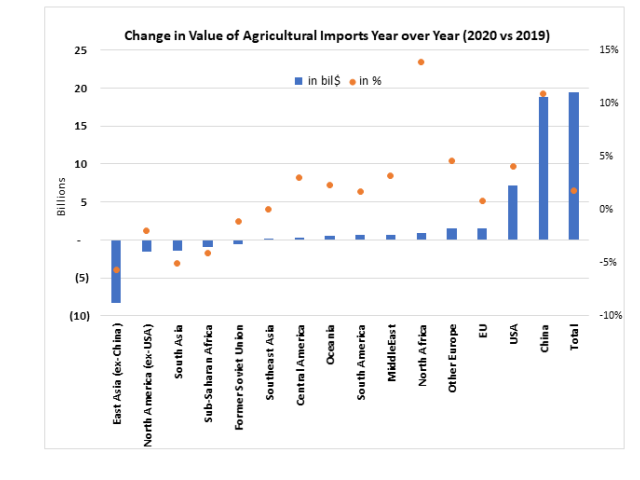Last year, as COVID-19 rattled the world economy and disrupted trade flows, agricultural trade remained mostly stable, falling only two percent during the initial wave of infections and lockdowns, before bouncing back and ending the year up 3.5 percent. But the growth in agricultural trade doesn’t mean that trade flows were insulated from the effects of the pandemic. Much of 2020 was in fact shaped by other factors. For instance, 95% of global agricultural trade growth came from China and was driven in part by non-pandemic related factors of increased feed demand, efforts to restock grain reserves, and policy factors. A recent paper by USDA’s Office of the Chief Economist, Has Global Agricultural Trade been Resilient under COVID-19? Findings from an Econometric Assessment (PDF, 1.4 MB) (Arita et al.), suggests that while agricultural trade remained stable at the aggregate level, a deeper empirical analysis reveals there were still significant disruptions due to the pandemic.
The report, the first to isolate and quantify the different impacts of the pandemic on agricultural trade, uses several years of monthly trade and economic data, to analyze the impacts of COVID-19 incidence rates, restrictions imposed by governments, and reduced human mobility on trade. It estimates that COVID-induced reduction in global agricultural trade ranged from 5-10 percent, at the sector level, while significant, is still 2-3 times smaller than the estimated impacts on the non-agricultural sector. The report finds that non-food items (hides & skins, ethanol, cotton, and other commodities), meat products including seafood, and higher value agri-food products were most severely impacted by the pandemic. But for a large majority of food and bulk agricultural commodities the effects of the pandemic were limited or even positive (see Figure 1). Empirical findings of the report suggest that policy restrictions imposed by importing countries to curb disease spread and reductions in human mobility (voluntary and mandatory based) were the main drivers of the identified trade loss.
The paper is available (PDF, 1.4 MB) on the USDA Office of the Chief Economist website.
Figure 2







修改评论